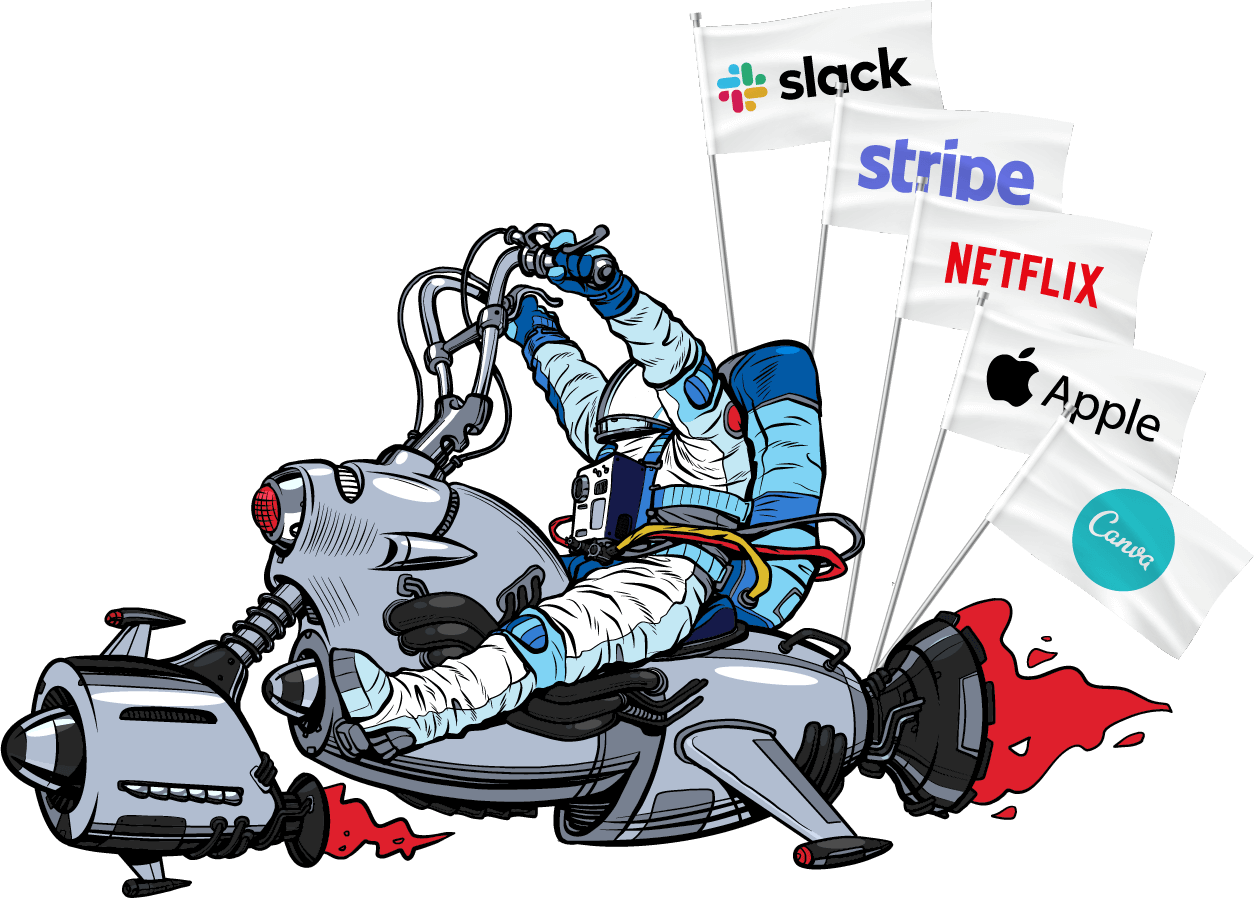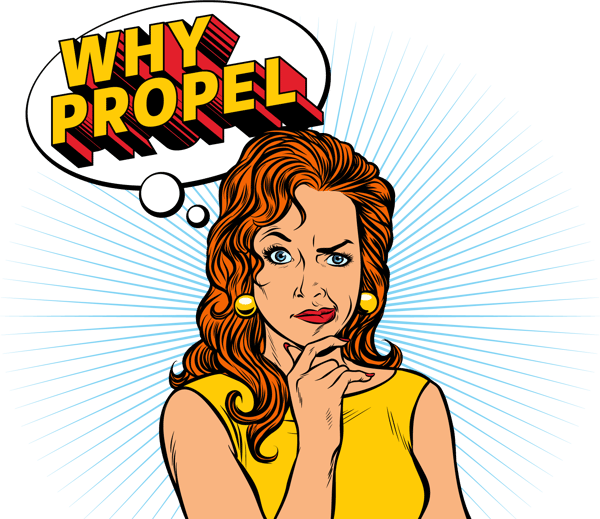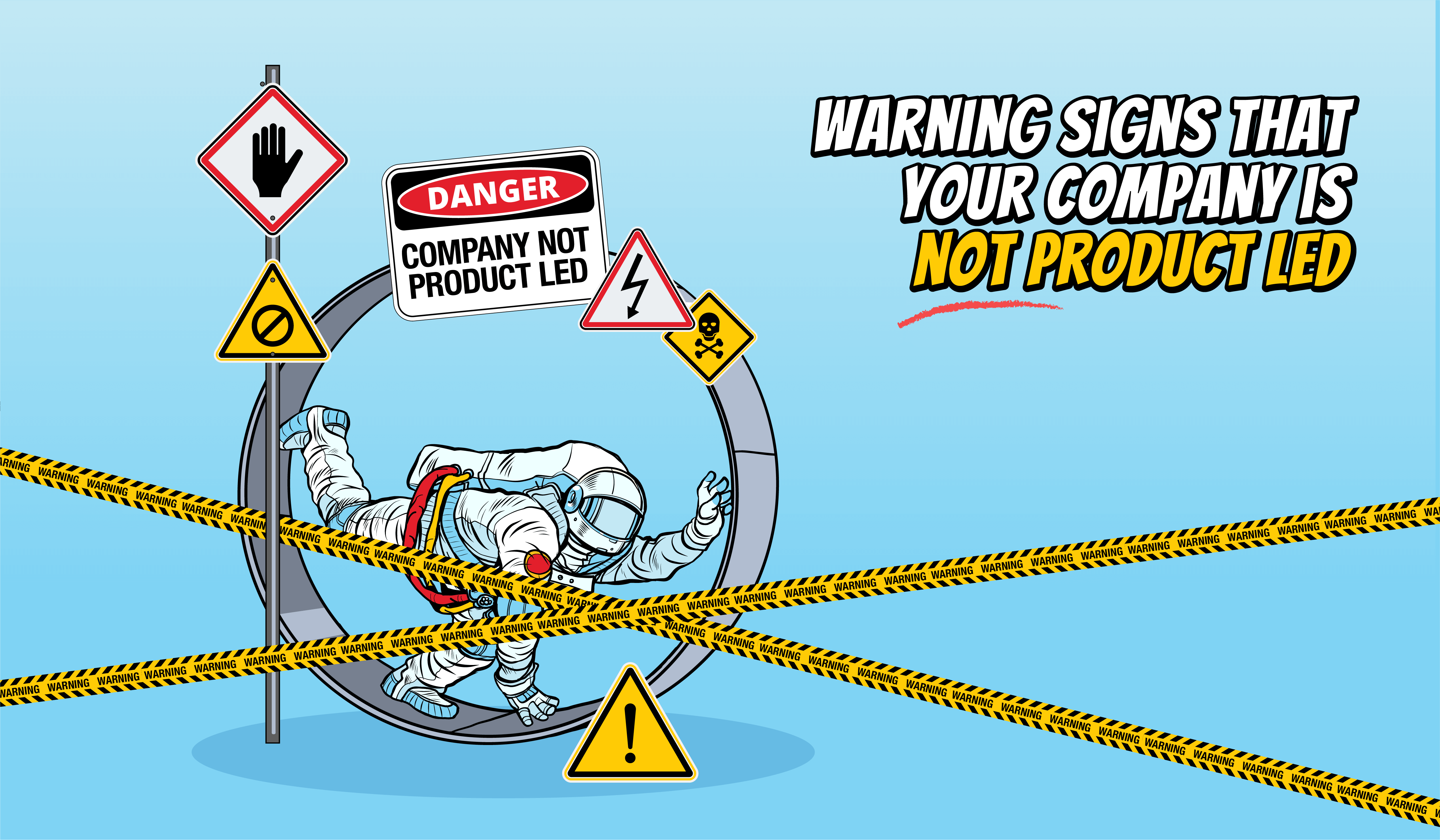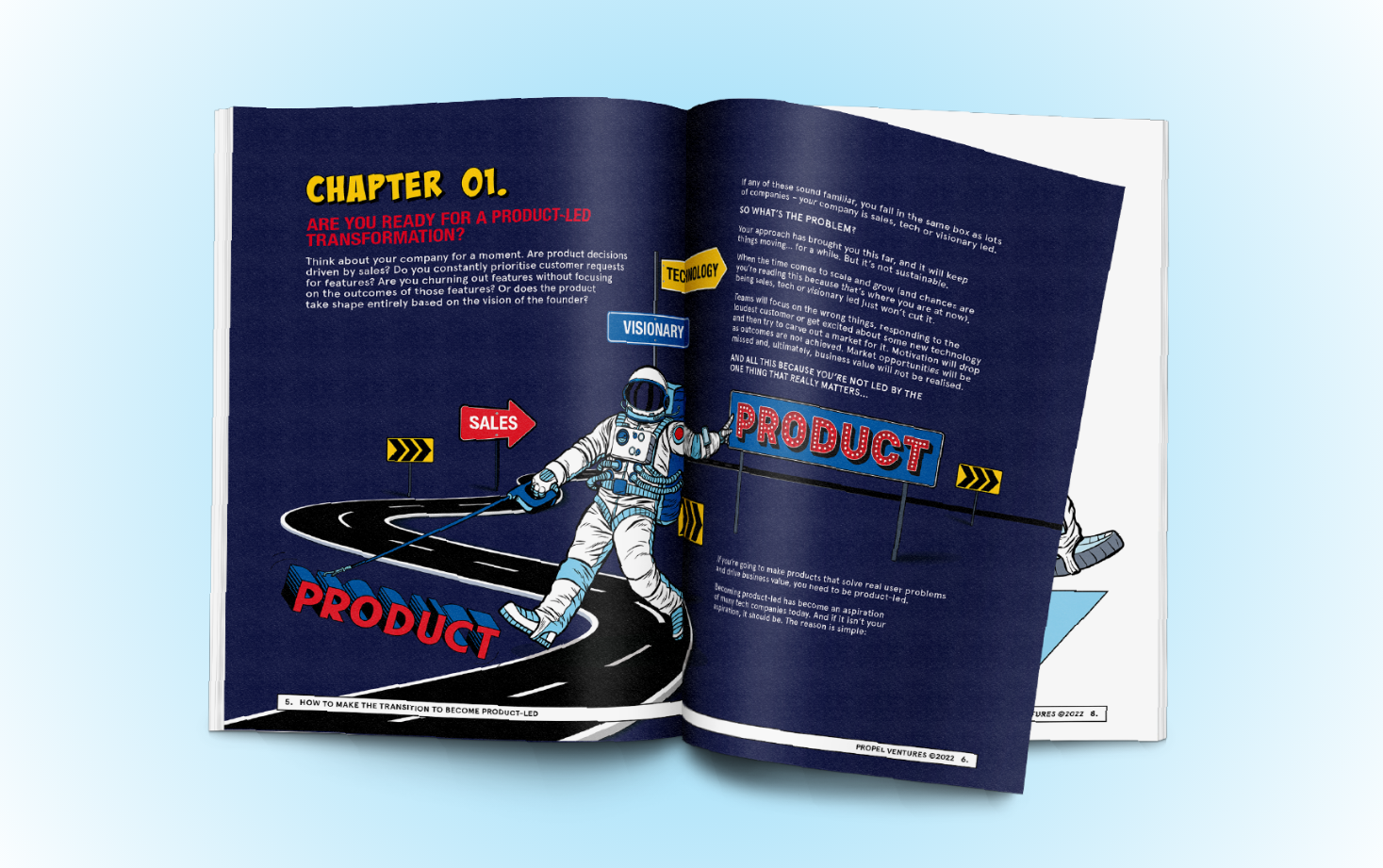
Using digital products to drive business growth
Propel Ventures can help you spot opportunities to modernise legacy systems or create new systems to drive business growth. Speak to us today!

PRODUCT LED GROWTH: THE ROCKET FUEL FOR YOUR BUSINESS

Product-Led Growth (PLG) is a transformative business strategy that harnesses the power of the product to drive customer acquisition, conversion, and expansion. For those unfamiliar with the product led growth meaning, the product takes center stage, designed to be intuitive, valuable, and user-friendly, empowering users to explore and engage with it independently. Prominent product led growth companies, companies like Slack and Zoom often employ freemium or free trial models to broaden their product's reach and impact.
As seasoned Product-Led Growth consultants, we have witnessed the numerous advantages this model offers. Implementing a product-led growth framework can significantly reduce customer acquisition costs, elevate customer lifetime value, enhance satisfaction, and boost brand awareness, making it a more compelling alternative to sales-led growth. A key strength of PLG lies in its ability to generate viral loops and organic user acquisition. When users have a positive experience, they naturally spread the word and refer others, resulting in powerful word-of-mouth marketing. This organic growth not only saves on customer acquisition expenses but also establishes a loyal user base.
However, transitioning to a product-led business comes with its challenges. Creating a product that drives growth and effectively measuring the success of your product led growth strategy often requires a business to undergo a product-led transformation. With our expertise as guides, we assist companiess on their journey toward product led growth, helping navigate these challenges and chart a clear path to success. The choice between product-led growth v sales-led growth should not be vague. By partnering with us, the shift to PLG becomes an opportunity to accelerate your growth and transform your business into a success story.
CHOOSING THE RIGHT GROWTH TRAJECTORY: PRODUCT-LED VS SALES LED STRATEGIES
Sales-led growth and product-led growth are two contrasting methodologies in the business world, each offering unique approaches to driving growth and achieving success. The traditional sales-led approach hinges on sales representatives, whose primary role is to sell the product to customers. Conversely, product-led growth is a more contemporary approach, using the product's inherent value to stimulate growth.
Sales-led growth, a classic strategy, relies on a team of sales representatives who actively engage potential customers, qualifying them as leads before sealing the deal. This method can indeed expedite business growth, but it often comes with a heavy price tag, requiring a significant investment of time and resources.

In contrast, the product-led growth meaning lies in its innovative perspective that places the product center stage. Product led growth companies, with remarkable examples such as Dropbox and Atlassian, develop products so valuable that customers are naturally inclined to discover, engage and purchase them. This approach often incorporates freemium or free trial models, making the product readily accessible to a vast user base. Product-led growth proves to be a cost-effective pathway to robust business growth compared to the sales-led approach, capitalizing on the product's inherent efficiency.
Choosing between product-led growth and sales-led growth requires careful consideration, taking into account factors such as target market, product characteristics, and budget. There is no one-size-fits-all formula for growth strategies. Thorough research and analysis are crucial for businesses contemplating the adoption of a product led growth framework. As product-led growth consultants, we specialize in assisting companies in navigating this transition, unravelling the complexities, and unlocking the immense potential of a product-led strategy.

MAPPING THE FLIGHT PATH: PRODUCT-LED TIPS
The transition from a sales-led to a product-led growth (PLG) model is gaining significant traction. The shift towards PLG pivots the focus onto the product itself, leveraging it as the primary driver of customer acquisition, retention, and expansion. The potential benefits of embracing this model are numerous and impactful, paving the way for rapid, efficient, and cost-effective business growth.
From our experience, here are some practical tips and strategies to enable your business to harness the power of product to drive growth.
Identify Areas to Improve Acquisition, Retention, and Engagement
As product led growth consultants, we understand the journey towards product-led growth (PLG) involves a systematic identification of areas needing improvement in acquisition, retention, and engagement. The process starts with mapping out the customer journey, and pinpointing key touchpoints to enhance user experience (UX) and value exchange. This comprehensive view of user interaction with your product allows you to see where your product can be made more compelling and attractive to customers.
Develop a Product-Led Growth Strategy
Formulating a product-led growth strategy forms the nucleus of the PLG approach. This strategy requires a clear delineation of goals and a roadmap outlining how to achieve them. Prioritizing product outcomes and defining success measures guide this strategic formulation. Your PLG strategy could be oriented towards increasing user acquisition, amplifying retention, or enhancing user engagement.
A clear set of goals coupled with metrics to gauge their success provide the foundation for your PLG strategy. These defined metrics function as guiding lights, steering your business towards achieving its objectives.
Organize the Team Around Customer Value Streams
Organizing your team around customer value streams is crucial. Aligning team organization with the various types of customer interaction with your product ensures a collective effort towards accomplishing PLG goals.
You could consider segregating teams based on customer acquisition, engagement, and retention. This focused approach enables a well-rounded strategy that effectively addresses all facets of the customer journey.
Build Great Products with UX and Iterate and Learn
Building outstanding products with a significant emphasis on UX design principles is integral to a successful PLG approach. Products that are user-friendly, provide substantial value to customers, and offer an enjoyable and intuitive experience make for successful PLG.
Adding to this, we recommend an iterative approach to product development. Continuously refining your products based on customer feedback enhances their value proposition over time, making them even more attractive to your user base.
PROPELS MISSION CONTROL SERVICE IS THE CATALYST YOUR BUSINESS NEEDS TO IGNITE ITS PRODUCT-LED GROWTH JOURNEY
Companies are realizing the immense power of product-led transformation in driving sustainable growth and unlocking their true potential. However, becoming a product-led business is no easy feat; it requires a fundamental transformation of your organization's focus towards the exceptional products you build. Propel Ventures unique mission control service can provide your business the tailored support you need to transition towards a product-led approach at scale. By embarking on a product-led transformation journey, you not only have the opportunity to enhance your products and services but also lay a robust foundation for product-led growth—a powerful and sustainable pathway to success.

Tailored Transformation Plans
Collaboration is at the heart of our mission control service. We work closely with you to understand your business's specific needs, challenges, and goals. By leveraging our expertise and industry insights, we craft a customized transformation plan that aligns with your unique business. This tailored approach ensures that every step of the journey is designed to maximize your business and products potential.
Shifting Mindset, Culture, and Processes
To drive lasting change and growth, it is crucial to cultivate a customer-centric mindset, foster a supportive culture, and streamline processes. Our mission control service identifies change agents within your organization who will champion this transformation. Through targeted strategies and interventions, we empower these change agents to lead the shift, creating a ripple effect that permeates throughout the entire business. By aligning your team's focus with the products vision, mission and strategy.
Ongoing Product Coaching and Support
Product coaching plays a vital role in sustaining the momentum of your product-led growth journey. Our experienced product management coaches provide ongoing support, guidance, and expertise to your team. Through regular check-ins, workshops, and training sessions, we ensure that your organization stays on track and can make the shift towards product-led. Our coaching framework empowers your team to make informed decisions, optimize product strategies, and unlock new opportunities.
Product-Led Insights
Warning signs that your company is not product led
Learn the difference between successful and unsuccessful product-led companies.
To build powerful products you first need to build empowered teams. Here’s why.
Learn about the three types of product teams and understand their differences in managing risks.
How to approach your transition to product led
Find out why being product-led means empowering your product teams to solve customer problems and be successful
FREQUENTLY ASKED QUESTIONS
What are product led companies?
Product-led companies are businesses that orient their growth strategies around their product, with the primary aim of delivering maximum value to the customer. These companies embrace strategies such as aligning their entire organization around customer value streams, which ensures all facets of the business work towards enhancing user experience. They share and socialize their product vision and mission throughout the organization, fostering unity and a common sense of purpose. Moreover, they align all their teams behind a singular product strategy, which includes clear goals, timelines, and key performance indicators. Shared success measures are a common feature in these companies, promoting a culture of shared responsibility and mutual accountability. Lastly, product-led companies employ outcome-based roadmaps, focusing on achieving specific business outcomes rather than merely delivering product features. This strategic focus on the product and its value to the customer is the driving force behind the growth of product-led companies.
What strategies can businesses use to adopt product led growth?
Adopting a product-led growth (PLG) strategy involves several key steps. Firstly, ensure your product is easy to use to enhance user experience. Secondly, offer a free trial or a freemium model, allowing potential customers to try your product risk-free. Thirdly, provide excellent customer support to boost customer retention. Fourthly, measure your results using key metrics to gauge the effectiveness of your PLG strategies. Additionally, align all teams within your organization behind your PLG strategy to ensure cohesive implementation. Lastly, organize your success measures around value streams, which focus on the value your product offers to its users. In essence, these strategies aim to make your product the core of your customer's journey, leading to mutual benefits for both the customer and your business.
What are the advantages and disadvantages of product led growth?
Advantages of Product-led Growth:
Increased customer acquisition: PLG strategies typically involve a user-friendly product, which serves as its own best advertisement. This has the potential to attract new customers efficiently.
Increased customer retention: When customers find value in a product, they are more likely to continue using it. A product-led approach can foster customer loyalty and prolong the customer lifecycle.
Reduced marketing costs: In a product-led approach, the product serves as the primary lead generator. This can lead to reduced marketing expenditure as the need for traditional advertising may be significantly lessened.
Improved product-market fit: A PLG strategy offers the opportunity for businesses to gather robust user data. This can enable companies to improve their products based on real user feedback and usage patterns, thereby enhancing the product-market fit.
Disadvantages of Product-led Growth:
Requires a great product: A product-led approach demands a compelling product. If the product doesn't meet customer expectations or fails to provide sufficient value, it can't drive growth.
Requires a strong marketing team: Despite the product being the primary growth driver, a proficient marketing team is still necessary to generate awareness and stimulate interest.
Requires a good onboarding process: The onboarding process is crucial in a PLG strategy. It's important that customers understand how to use the product effectively from the onset, otherwise, they may churn.
Requires your business to be organized around product and customer streams: Implementing a PLG strategy necessitates a business structure aligned with various customer interaction points and product-focused teams.
What is an example of a product-led approach?
A Product-led growth, where the product is the main driver for attracting, retaining, and expanding the customer base, is an increasingly popular business strategy. Here, we highlight some exemplary product-led growth companies, which have masterfully implemented this approach to fuel their success.
Dropbox, a leading file-sharing service, stands out as a stellar example of product-led growth. Offering a free trial of their service allows users to experience the product's value firsthand, often prompting an upgrade to a paid plan. Through this strategy, Dropbox showcases how a product-centric approach can drive significant growth.
Another product-led growth example can be seen in Slack, an acclaimed team collaboration platform. Using a freemium model, Slack provides a basic feature set for free, encouraging users to upgrade for more advanced capabilities. This product-led growth strategy makes the tool's inherent value the primary driver for customer acquisition and retention.
Lastly, we have Grammarly, a widely-used grammar-checking tool, demonstrating another product-led growth success story. Much like Dropbox, Grammarly offers a free trial that allows users to test the service and witness its benefits. This approach often leads to a subscription purchase, driving growth and cementing Grammarly's position as one of the successful product-led growth companies.
In all these instances, the companies have optimized their products as the primary growth drivers, creating a compelling narrative around the product's value. By focusing on the product, these companies have managed to turn users into paying customers, amplifying their business growth—a clear testament to the power of a product-led growth approach.
Product Success Playbook:
How to make the transition to become product led, Part 1
Curious about the benefits of a product-led approach and whether your company is ready for transformation? This playbook is for you.
Product Success Playbook:
How to make the transition to become product led, Part 2
Ready to make the transition to a product-led organisation? Discover the five practical steps used by today’s winning companies and global product leaders.




